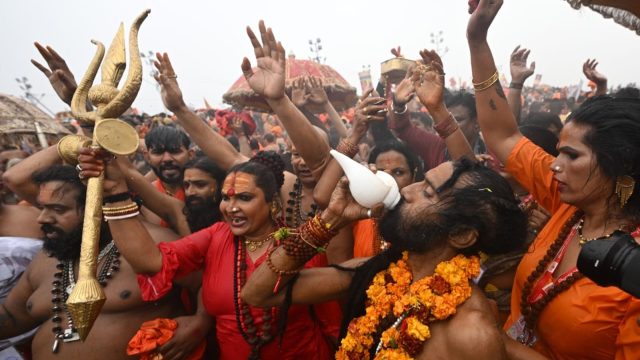📣 For more lifestyle news, click here to join our WhatsApp Channel and also follow us on Instagram
Samudra Manthan: Know all about the ‘pauranic’ story behind why Kumbh Mela came into being
The term ‘Kumbh’ comes from the root ‘kumbhak’ (the sacred pitcher of elixir of immortality).
 Discover the mythological origins and spiritual significance of the Kumbh Mela, rooted in the Puranas, Samudra Manthan, and India’s enduring faith in divine and natural forces. (Express photo by Vishal Srivastava)
Discover the mythological origins and spiritual significance of the Kumbh Mela, rooted in the Puranas, Samudra Manthan, and India’s enduring faith in divine and natural forces. (Express photo by Vishal Srivastava)The Kumbh Mela, celebrated as one of the world’s largest religious gatherings, has multiple origin stories. This grand festival is much more than a congregation; it represents a confluence of spirituality, history, and mythology that millions of Hindus have cherished for centuries.
According to Acharya Lalmani Panday of Panipat’s 18th-century temple Devi Mandir, the story of the Kumbh Mela is intertwined with the legend of the Samudra Manthan (churning of the ocean), a significant episode in Hindu mythology.
Here’s the story of Samudra Manthan
According to the Puranas, both the Devas (gods) and the Asuras (demons) sought the elixir of immortality, Amrit. To obtain it, they churned the cosmic ocean using Mount Mandara as the churning rod and Vasuki, the serpent king, as the rope. When the Amrit finally emerged, a fierce battle broke out between the two groups for its possession, he said.
The gods, fearing the Asuras’ intentions, entrusted Lord Vishnu to safeguard the Amrit. Disguised as the enchanting Mohini, Vishnu cleverly whisked the Kumbh (pitcher) of nectar away from the Asuras. In his celestial flight, drops of the sacred nectar fell at four locations on Earth—Haridwar, Ujjain, Nashik, and Prayagraj—imbuing them with divine significance.
 The tradition of the Kumbh Mela finds mention in ancient scriptures, according to kumbh.gov.in. (file)
The tradition of the Kumbh Mela finds mention in ancient scriptures, according to kumbh.gov.in. (file)
The journey of Vishnu with the Kumbh lasted twelve divine days, equivalent to twelve human years. Hence, the Maha Kumbh Mela is celebrated every twelve years at these four sites in a rotating cycle, acharya Panday explained. The rivers at these sacred locations—Ganga, Shipra, Godavari, and the confluence of Ganga, Yamuna, and the mythical Saraswati—are believed to have turned into Amrit during this period, as per the official site of Kumbh Mela. Pilgrims believe that bathing in these waters cleanses the soul and brings liberation from the cycle of birth and death.
The tradition of the Kumbh Mela finds mention in ancient scriptures, according to kumbh.gov.in. “The term ‘Kumbh’ comes from the root ‘kumbhak’ (the sacred pitcher of elixir of immortality). There is a mention of ‘Kumbh’ and the bathing ritual associated with it in the Rig Veda (verse 10.89.7). It speaks of the benefits of bathing at sangam during this period, elimination of negative influences and rejuvenation of mind and soul. Prayers for the ‘Kumbh’ are also expressed in Atharva Veda and Yajur Veda,” the site reads.
The Chinese traveller Hsuan Tsang, in his writings, describes the grandeur of a fair in Prayag in the seventh century, presumed to be the Kumbh Mela, and King Harsh’s acts of charity, including distributing wealth to ascetics and scholars.
As per the official government site, the philosopher Adi Shankaracharya also played a crucial role in institutionalising the Kumbh Mela by establishing ten Akharas (monastic orders) and formalising the rituals associated with the event.
📣 For more lifestyle news, click here to join our WhatsApp Channel and also follow us on Instagram
Photos



- 01
- 02
- 03
- 04
- 05























